Do Bleeding Hearts Like Sun or Shade? The Right Light for Kitchen Garden Success
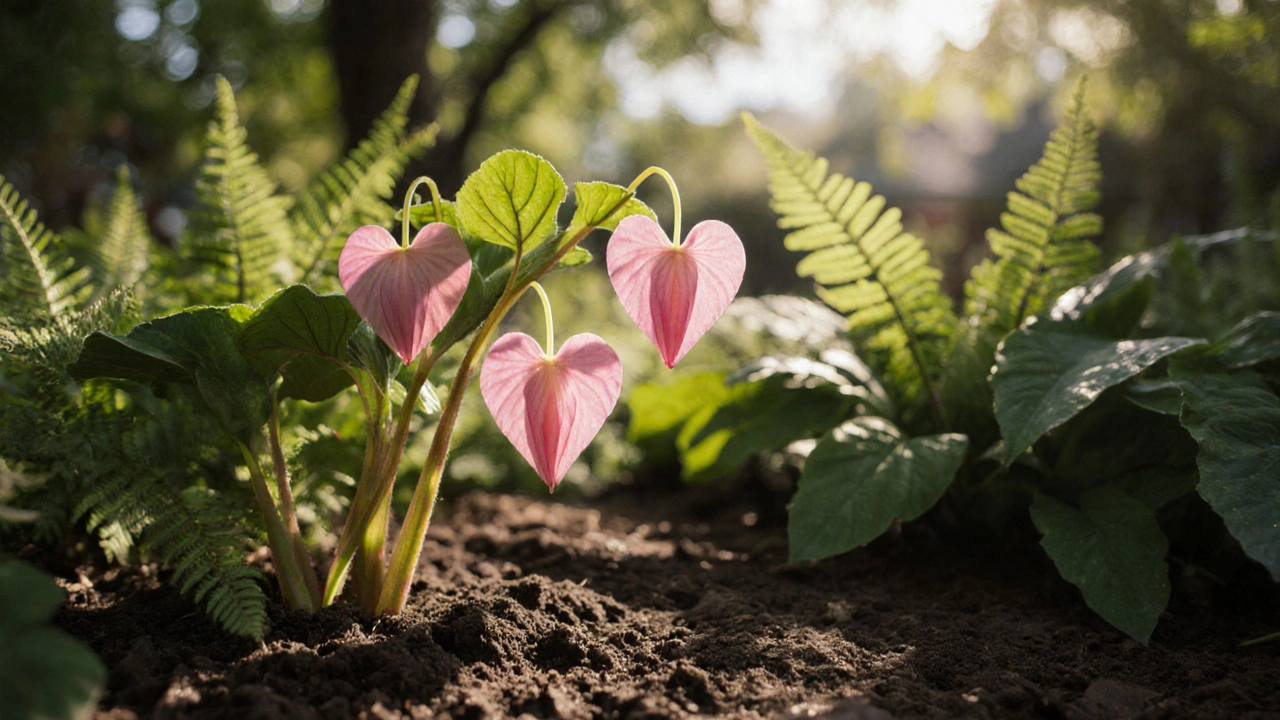
Do Bleeding Hearts Like Sun or Shade? The Right Light for Kitchen Garden Success
Bleeding Heart Light Condition Checker
Check Your Garden Spot
Assess if your garden location meets bleeding heart plant requirements
If you’ve ever seen a bleeding heart plant blooming in a shady corner of a garden, you know why it’s a favorite for kitchen gardens. Its delicate, heart-shaped flowers dangle like little pink or white lanterns, adding quiet charm to spaces where other flowers won’t thrive. But here’s the question most gardeners ask: Do bleeding hearts like sun or shade? The answer isn’t just about aesthetics-it’s about survival.
They’re naturally shade lovers
Bleeding hearts (Lamprocapnos spectabilis, formerly Dicentra spectabilis) evolved in the cool, dappled woodlands of Asia and eastern North America. That means they’re built for filtered light, not direct sun. In the wild, they grow under trees, where the canopy breaks the midday heat and keeps the soil moist. In your kitchen garden, that translates to a north-facing spot, under a deciduous tree, or beside a fence that casts afternoon shade.Plant bleeding hearts in full sun, especially in warmer climates like Auckland, and you’ll see the leaves turn pale, curl, and eventually burn. The plant won’t die right away, but it will struggle. Flowers will be sparse, the stems will stretch weakly, and the whole plant may go dormant early-sometimes as soon as June. That’s not normal. That’s stress.
What does ‘partial shade’ really mean?
You’ll hear gardeners say ‘partial shade’ and assume it means two hours of sun. That’s not enough. Bleeding hearts thrive in morning sun and afternoon shade. In New Zealand’s climate, that means getting sunlight from 7 a.m. to 11 a.m., then being protected from the stronger light after noon. A spot under a pergola with climbing vines, beside a tall shrub, or on the shaded side of a garden shed works perfectly.Even in cooler months, when the sun is lower in the sky, avoid planting them where they’ll get direct midday rays. The soil under a bleeding heart should feel cool to the touch, not hot. If you’re unsure, test the spot with a soil thermometer. If it hits 25°C or higher in the afternoon, move it.
Soil matters more than you think
Light isn’t the only factor. Bleeding hearts need rich, loose soil that drains well but holds moisture. Think of it like a sponge that doesn’t drown. Heavy clay? Add compost. Sandy soil? Mix in leaf mold or aged manure. Aim for a pH between 6.0 and 7.0. You don’t need fancy products-just good organic matter.One mistake I’ve seen too many times: people plant bleeding hearts in the same spot as their herbs or veggies, thinking ‘kitchen garden’ means full sun and dry soil. That’s the wrong mindset. Kitchen gardens aren’t just for tomatoes and basil. They’re for beauty, too. Bleeding hearts belong in the quiet corners, tucked between rosemary bushes or behind a row of lettuce. They don’t compete-they complement.
Seasonal behavior: dormancy isn’t failure
If your bleeding heart suddenly drops its leaves and vanishes in late summer, don’t panic. That’s normal. These plants go dormant after flowering, especially in warmer weather. The roots stay alive underground, waiting for cooler, wetter conditions. Don’t dig them up or assume they’re dead. Just mark the spot with a small stake. In autumn, when rain returns, new shoots will rise again.Some gardeners treat dormancy like a problem to fix. They water more, fertilize, even move the plant. That’s the worst thing you can do. Let it rest. Overwatering during dormancy causes root rot. A little mulch around the base is enough to protect the roots from drying out.
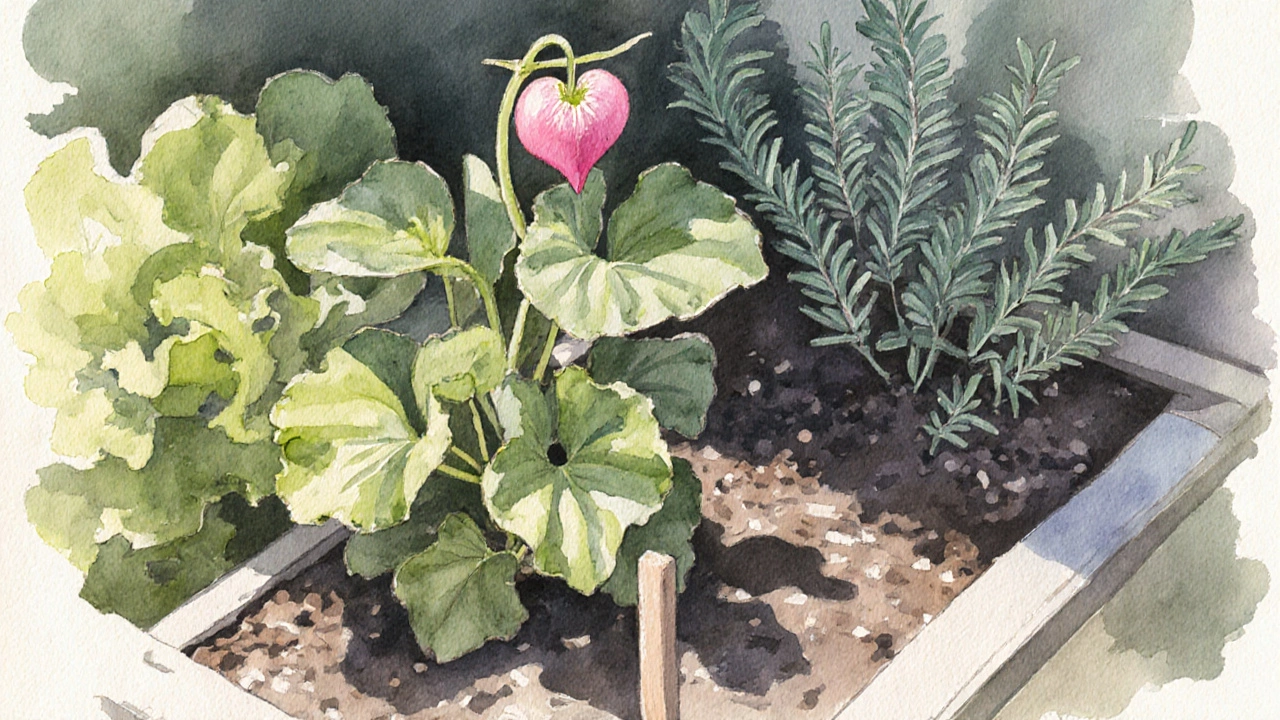
What about container planting?
Bleeding hearts do well in pots-if you get the conditions right. Use a large container (at least 40 cm wide) with drainage holes. Fill it with a mix of potting soil, compost, and perlite. Place the pot where it gets morning sun only. In summer, move it deeper into shade if the leaves start to fade. Keep the soil consistently moist but never soggy.One pro tip: pair your bleeding heart with other shade-loving plants in the same pot. Ferns, hostas, or lamium create a mini-woodland effect. The contrast of textures makes the bleeding heart’s flowers stand out even more. And since kitchen gardens are often small, container planting lets you move the plant around as seasons change.
Winter care in New Zealand
Auckland’s mild winters are perfect for bleeding hearts. No need to cover them or bring them indoors. A light layer of leaf mulch around the base helps retain moisture and keeps the soil temperature stable. If you get a hard frost, the foliage may blacken, but the roots will survive. Cut back the dead stems in late winter, just before new growth starts.Don’t fertilize in winter. These plants don’t need it. Too much nitrogen in cold months encourages weak, leggy growth that won’t survive spring winds. Wait until early September, when the first buds appear, then give them a light feeding with compost tea or a slow-release organic fertilizer.
Common mistakes and how to avoid them
- Mistake: Planting in full sun because ‘all flowers need sun.’ Solution: Observe your garden’s light patterns for a full day before planting.
- Mistake: Watering daily in summer. Solution: Water deeply twice a week, letting the top 2 cm of soil dry between sessions.
- Mistake: Assuming it’s dead when it goes dormant. Solution: Mark the planting spot and wait until autumn.
- Mistake: Using chemical fertilizers. Solution: Stick to compost, worm castings, or seaweed extract.
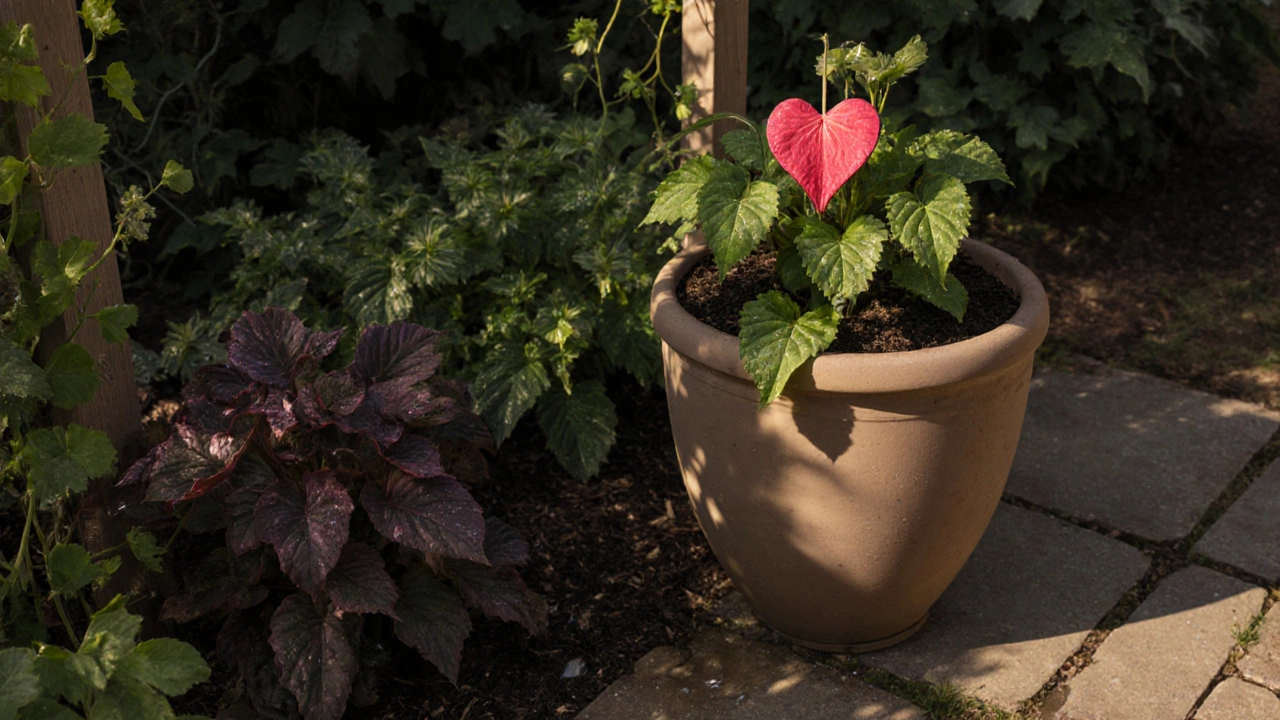
Why this plant fits perfectly in a kitchen garden
Kitchen gardens aren’t just about food. They’re about spaces that feel alive, calming, and connected to nature. Bleeding hearts bring that. They bloom in early spring when most veggies are still small. They add color without taking up much room. And because they’re not edible, they don’t compete with your herbs or vegetables for sunlight or nutrients.Plant them along the edge of a raised bed, beside a compost bin, or tucked under a fruit tree. They’re low-maintenance, long-lived (up to 10 years in good conditions), and attract pollinators like bumblebees. In a world where gardens are often treated like chores, bleeding hearts remind us that beauty doesn’t have to be high-effort.
What to plant next to bleeding hearts
- Ferns: Soft texture contrasts with the delicate blooms.
- Hostas: Bold leaves frame the bleeding heart’s fine flowers.
- Lamium: Spreading ground cover that keeps weeds down.
- Heuchera: Colorful foliage that lasts all season.
- Native toetoe: If you’re in New Zealand, this tall grass adds height and movement without crowding.
Avoid planting them next to aggressive spreaders like mint or comfrey. Bleeding hearts are gentle. They don’t fight. Give them space, and they’ll reward you.
Can bleeding hearts grow in full shade?
Yes, bleeding hearts can grow in full shade, but they’ll bloom less. They need at least a few hours of morning light to produce flowers. In deep, dark shade-like under a dense evergreen-they’ll survive but may only grow leaves and no flowers. Aim for dappled or partial shade instead.
Why are my bleeding hearts turning yellow?
Yellow leaves usually mean too much sun or poor drainage. If the soil is soggy, roots are rotting. If it’s dry and the plant is in direct afternoon sun, it’s scorched. Move the plant to a shadier spot and check the soil. Add compost to improve drainage if needed.
Do bleeding hearts come back every year?
Yes, bleeding hearts are perennial in most climates, including Auckland. They die back in summer but return each spring from their underground roots. As long as the roots aren’t damaged by frost, waterlogging, or digging, they’ll come back for 5-10 years.
Are bleeding hearts toxic to pets?
Yes, all parts of the bleeding heart plant are toxic if eaten. They contain isoquinoline alkaloids that can cause vomiting, diarrhea, or lethargy in dogs and cats. Keep them away from pets that dig or chew plants. They’re safe to grow near pets if kept out of reach.
When should I divide my bleeding heart plant?
Divide bleeding hearts in early spring, just as new shoots appear, or in autumn after they’ve gone dormant. Use a sharp spade to cut through the root clump, making sure each section has at least one eye (growth bud). Replant immediately and water well. Don’t divide more than once every 4-5 years.
Final tip: Let nature lead
Bleeding hearts don’t need much. They don’t demand attention. They thrive when you give them the quiet, cool, moist space they evolved for. In a kitchen garden full of busy veggies and herbs, they’re the quiet guest that stays late, blooms softly, and leaves no mess. Plant them where the sun doesn’t burn, where the soil stays cool, and where you can sit and watch them bloom without pulling weeds or chasing pests. That’s the real joy of kitchen gardening-not just what you eat, but what you feel.About
Gardener Support India is your go-to online destination for expert advice on gardening and horticultural services in India. Whether you're a beginner or an experienced gardener, our platform offers extensive resources, tips, and support tailored to Indian climates and plant species. Explore a wide range of guides on plant care, sustainable gardening practices, and innovative gardening solutions. Connect with local experts to enhance your gardening experience and maintain a flourishing garden. Our dedicated services aim to empower Indian gardeners with the knowledge and tools needed for a successful gardening journey.
Latest Posts


The Hidden Drawbacks of Rooftop Farming
By Alden Thorne Sep 30, 2025

Which Vegetable Farming is Profitable in India? Your Practical Guide
By Alden Thorne Apr 25, 2025
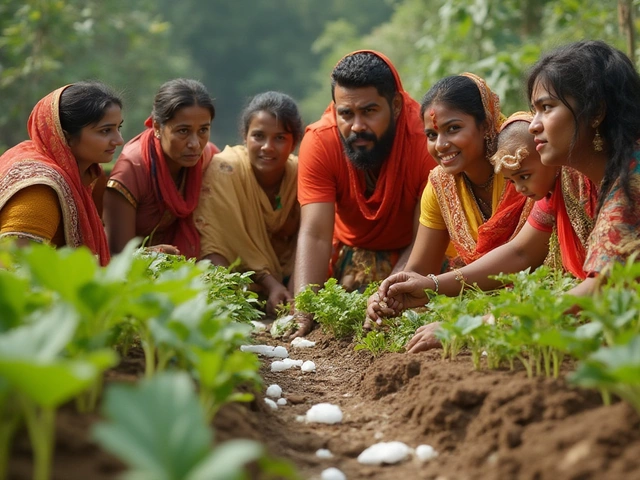
Is Styrofoam Safe for Vegetable Gardens? The Truth About Using Polystyrene in Gardening
By Alden Thorne Jul 5, 2025
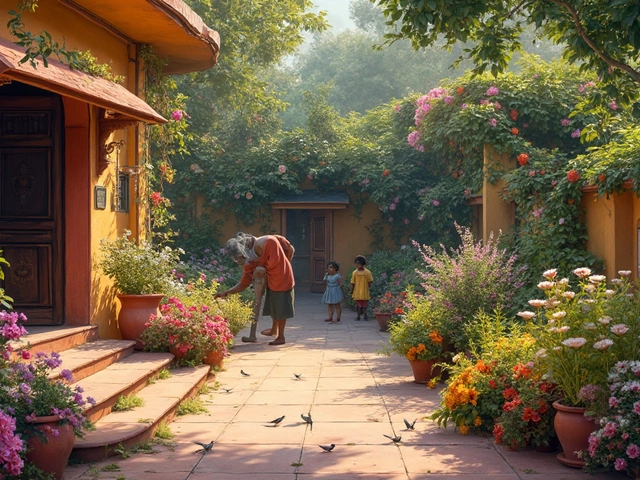
Write a comment